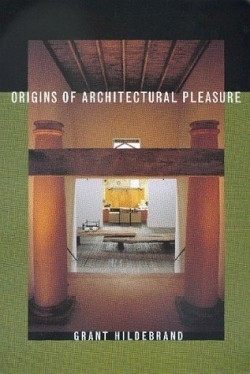Origins of Architectural Pleasure
In the recent words of artist Vito Acconci, “Architecture exists because nature is dangerous.” This book assumes a similar starting point for examining what constitutes and governs the sensation of pleasure derived from environments that are constructed.
The author, Grant Hildebrand, a professor of architecture and art history at the University of Washington in Seattle, takes as his premise for this examination the correlation between the characteristics of our environment that have improved our chances of survival and those we actually like and find pleasurable. Drawing upon theories of human behavior and the biological process of natural selection, he suggests that looking at human development in terms of what has been advantageous for the survival of the species can be a useful model for determining how our environmental and architectural preferences have developed. He also maintains this approach as a method for analyzing architectural principles across widely divergent time periods, cultures, geographic constraints; and levels of technological sophistication.
Leading the reader through the mechanism of the human survival response and its impulses in cognitive process, cultural belief and instinct, Hildebrand quickly establishes a foundation for a link between the natural sciences and the development of an inherent aesthetic sensibility. To do this, he begins with an inquiry into what appropriate habitation for homo sapiens actually is, what activities require shelter, and what specific architectural characteristics support this. He postulates that the characteristics that drive our responses function as environmental archetypes, images that exist within us “in some degree of abstraction.” What is it within us, he wonders, that universally responds to the sound of a river or the way a wave catches light, the feeling of standing at the edge of a wood and the security of hearing the sound of rain on the roof while we lay safe in bed? It is not just a drive for comfort and protection, but also the psychological dimension of comfort.
Hildebrand adopts British geographer Jay Appleton’s concepts of a prospect-refuge model of the environment. Refuge being not only a place of protection, but of concealment; prospect the opportunity for clear vistas and command. Paradoxi-cally these two opposing conditions provide a sense of comfort, generating at once a feeling of intimacy and control. His point is that some architectural scenes and some natural ones “accord in form and space, in light and darkness” with archetypal images whose physical manifestations have “conferred a survival advantage.”
It is Hildebrand’s application of these principles to architectural space that is perhaps the most engaging aspect of his contemplation. Drawing from such well-known architectural examples as the houses of Adolf Loos, Mario Botta, Frank Lloyd Wright and Le Corbusier to the Court of Lions in the Alhambra, traditional Japanese building and the cathedrals of Europe, his discussion follows the application of this model to plan and section, interior and exterior space, as well as the enhancement of the natural image by the architectural imposition.
There is also the sense of the poetic in this empiricism, as when he cites Gerd Sommerhoff’s concept of “cognitive consonance” and discusses the eye’s delight in ordered complexity, apparent in the way our brain processes shapes of regular order, such as flowers and circles, and the translation of this to architectural material. Or when illustrating an architectural principle he entitles “enticement” with the appeal of light levels in Chartes cathedral, he states, “One moves and seeks, drawn by the light of the window’s complex brilliance, yet never fully arrives.”
There is something akin here to Suzi Gablik’s romantic yearning for a revitalization of contemporary art in her 1991 book, The Reenchantment of Art. This is evident especially when Hildebrand speculates that the application of his model of investigation might “hold the promise of an architecture of widespread pleasure,” and that this pleasure might be “a legitimate architectural purpose.” Emphasizing the public aspect of the architectural arts, his position is that memorable buildings possess not only varying levels of sophisticated abstraction, but also visual accessibility. That artistic pleasure might not be a culturally popular belief, he readily admits. However, quoting Gyorgy Kepes he speculates that “art of importance might not only concern itself with what a society is; it might also address what a society needs.”
With many clear examples and architectural illustrations, this book outlines an investigation that those who contribute to the built environment might actively ponder.
Reviewed by
Kelley Flynn
Disclosure: This article is not an endorsement, but a review. The publisher of this book provided free copies of the book to have their book reviewed by a professional reviewer. No fee was paid by the publisher for this review. Foreword Reviews only recommends books that we love. Foreword Magazine, Inc. is disclosing this in accordance with the Federal Trade Commission’s 16 CFR, Part 255.

